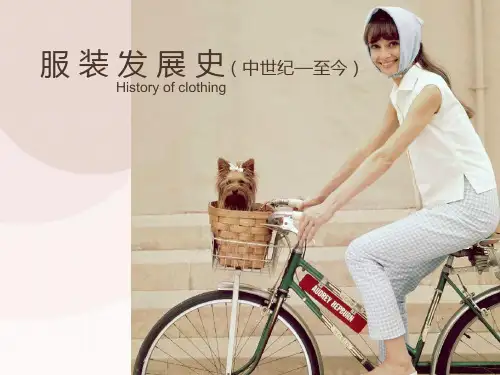西方服装发展史 英文版 PPT
- 格式:ppt
- 大小:7.38 MB
- 文档页数:50
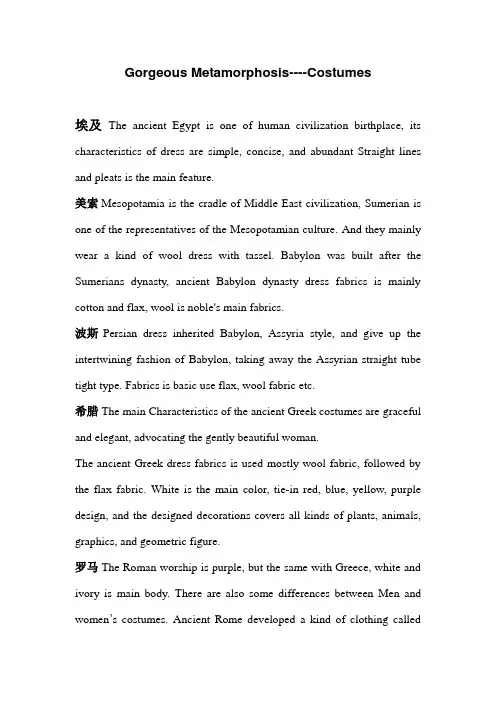
Gorgeous Metamorphosis----Costumes埃及The ancient Egypt is one of human civilization birthplace, its characteristics of dress are simple, concise, and abundant Straight lines and pleats is the main feature.美索Mesopotamia is the cradle of Middle East civilization, Sumerian is one of the representatives of the Mesopotamian culture. And they mainly wear a kind of wool dress with tassel. Babylon was built after the Sumerians dynasty, ancient Babylon dynasty dress fabrics is mainly cotton and flax, wool is noble's main fabrics.波斯Persian dress inherited Babylon, Assyria style, and give up the intertwining fashion of Babylon, taking away the Assyrian straight tube tight type. Fabrics is basic use flax, wool fabric etc.希腊The main Characteristics of the ancient Greek costumes are graceful and elegant, advocating the gently beautiful woman.The ancient Greek dress fabrics is used mostly wool fabric, followed by the flax fabric. White is the main color, tie-in red, blue, yellow, purple design, and the designed decorations covers all kinds of plants, animals, graphics, and geometric figure.罗马The Roman worship is purple, but the same with Greece, white and ivory is main body. There are also some differences between Men and women’s costumes. Ancient Rome developed a kind of clothing calledPala only for women citizens, which is made of linen. Toga is the largest world’s clothes, and according to the Roman law, only male Roman citizens can wear Toga made of wool fabrics.拜占庭Early Byzantine clothing continued the basic style of the Roman empire, white is the most main color. But with the development and popularization of Christian culture, colors of costumes become more and more magnificent, and tassel, trim and gem decoration is very popular. The most important Byzantine characteristic is its well-developed enamel technology. The color is flowery, gorgeous.哥特式Gothic style during the middle ages is the most representative style. It is based on the architecture of the cathedral characteristics as the representative of the name.文艺The human body curvaceous became the key aesthetic ideas of Renaissance clothingThe lady clothing focus moves down, upper body is the slender waist, down the body like scents exaggerated. This kind of style with Oriental silk, folding fan, and exquisite clothing accessories, constitute the theme of Renaissance’s dress.Men's costume is just the opposite巴洛克Baroque is the most bright crazy period of Men's clothingThe period of man regard the beauty as their life. They chase all exciting color and decorations for example the exaggeration about wigs, wearornate lapel, all kinds of lace big turndown, silk and so on. This period costumes have been discarded Renaissance style, completely into the world of feminine beauty.洛可可During the period of Rococo, splendid attire pushed women to the luxuriant acme . Women’s dress emphasis on mild adornment and full of colorful jade, flashy for women dress of decoration.Men's clothing basic inherited the form of the baroque period, just abandoned the heavy and complicated adornment, gradually absorbed English gentleman style, simple rigorous practical。
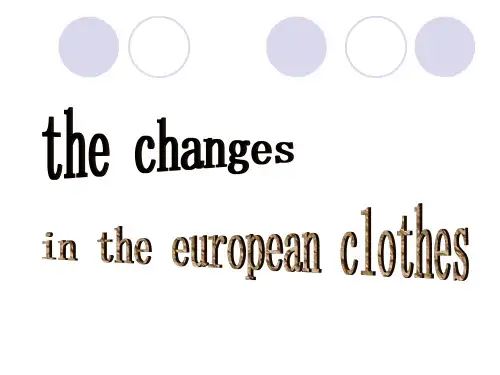
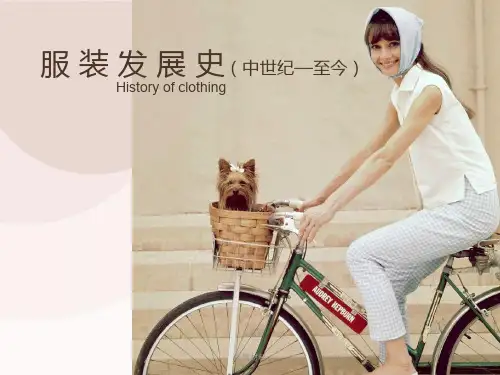


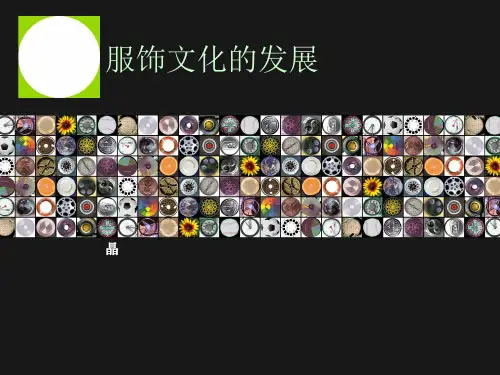
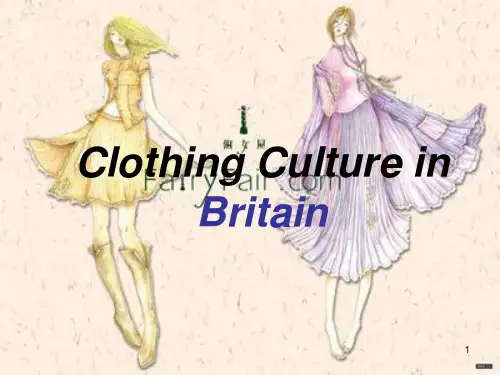

西方服装发展史(完整版)第一章:古代时期(公元前500年至公元500年)1.1 古埃及服装古埃及文明诞生于尼罗河流域,其服装风格独特,具有浓厚的地方特色。
古埃及人主要穿着缠腰布,男女皆然。
这种缠腰布称为“斯帕塔”,是一种长条形的布料,围绕腰部多层缠绕。
贵族和皇室成员的斯帕塔质地更为华丽,采用丝绸、麻纱等高档面料。
1.2 古希腊服装古希腊文明是西方文明的摇篮,其服装风格对后世产生了深远影响。
古希腊人崇尚自然,服装简约大方。
男性和女性都穿着长袍,称为“丘尼卡”。
丘尼卡是一种宽松的直筒形长袍,颈部、手臂和腰部有扣子或带子固定。
古希腊人还喜欢佩戴披肩,称为“霍莫”。
1.3 古罗马服装古罗马帝国时期,服装风格逐渐丰富多样。
古罗马人穿着宽松的长袍,称为“托加”。
托加是一种矩形布料,披在身上,通过不同的披挂方式展现身份地位。
古罗马时期还出现了内衣,如内衣裙和内衣裤。
士兵们穿着铠甲,以保护身体。
第二章:中世纪时期(公元500年至1500年)2.1 拜占庭时期服装拜占庭帝国继承了古罗马文化,服装风格兼具东西方特色。
拜占庭时期,服装讲究繁复华丽,使用大量金银丝线和珠宝装饰。
贵族女性穿着宽松的长袍,搭配披肩,头发饰以珠宝。
男性则穿着长袍和紧身裤。
2.2 哥特时期服装哥特时期,欧洲服装风格发生较大变革。
这一时期,服装注重展现身材线条,采用紧身上衣、窄裙和紧身裤。
女性流行穿着紧身胸衣,以突出胸部。
同时,哥特时期服装还出现了夸张的帽子和头饰。
2.3 文艺复兴时期服装文艺复兴时期,欧洲服装风格焕发新的活力。
这一时期,服装追求奢华、繁复,体现人文主义精神。
男性穿着宽松的短裤、长袜和紧身上衣,女性则流行穿着圆锥形胸衣、宽大的裙子和紧身马甲。
文艺复兴时期还出现了各种华丽的帽子和头饰。
第三章:近代时期(1500年至1900年)3.1 巴洛克时期服装巴洛克时期,欧洲服装风格更加奢华、夸张。
这一时期,服装采用大量蕾丝、花边、缎带等装饰,颜色鲜艳。
